A Port(o) in Every Storm
Remember how I said we wanted to sail to the Azores? Hmmm…

So – we untied from our pontoon in A Coruña an hour before dawn one Friday morning in mid-August. There was little wind and the sky was a Royal Navy blue with a smattering of stars still twinkling above us. We puttered quietly out of the marina and out into the last few miles of the Bay of Biscay before heading south down the Spanish coastline. The lighthouse beam swept across our bows as we slipped out quietly across the silvery waters.
A Coruña is the most north-westerly port city in Spain, at the mouth of the Bay of Biscay and just northeast of Cape Finisterre- an imposing slab of rocky headland that was previously thought to be the end of the world. Since the beginning of time, this has been a dangerous strip of coastline to sail, the beginning of what they still call the Costa da Morte, or coast of death. The nightmarish arsenal of fierce currents, strong winds and unmarked offshore rocks is augmented these days by a multitude of fishing pots, some barely marked, waiting to hook the rudder or wrap the propeller of any unwary passing vessel.
First we had to head west, then track round the headland to set a course due south for Muros, a bay in which to drop our anchor for the night. We expected to be there just as the sun was setting. That was the plan at least (you know how these things seem to go for us!)
As the sun rose, the wind picked up. It came from dead ahead (so sailing was not an option) and with our trusty 88hp Yanmar engine chuntering away below decks, we made slow headway west. As the land dwindled and we adjusted our course towards the south, so the wind bent around the headland to beat us back. Our progress got slower and slower and at about 3pm, still way too far north to have a chance at reaching Muros before nightfall, we looked again at the charts and decided to dive into a little anchorage nearby and drop the hook for the night there instead. It was a good call. The further south we motored, the stronger the wind got – by the time we arrived, with wind and current against us, it had taken us 3 hours to do the last 7 miles. I could have walked faster.
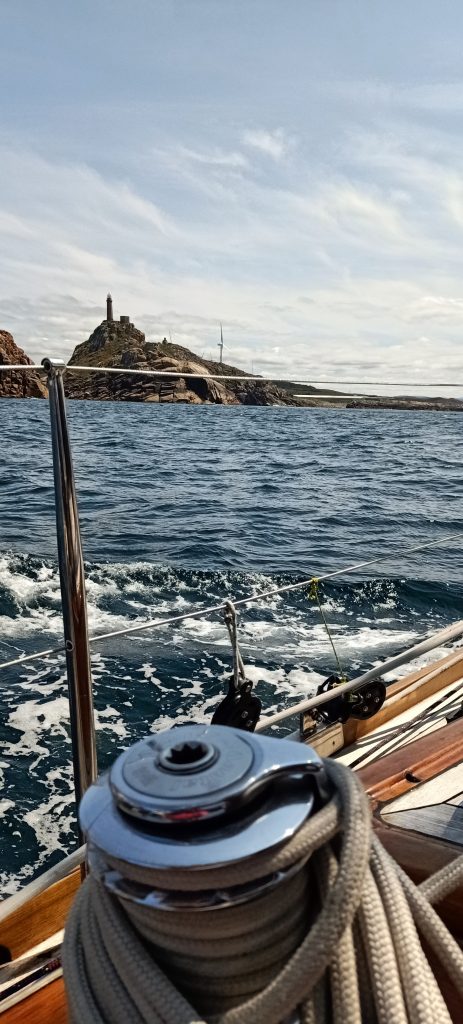
We rounded the headland to the ria, with its mighty lighthouse and fortress, and dropped anchor in an unremarkable but not unpretty bay, a couple of hundred metres off the small town of Camariñas. With our fingers, we ate the magnificent, huge prawns we had bought in A Coruña. Having polished off the other half of the cider bottle we had bought in Brest, we turned in for the night with our anchor light on and our anchor watch alarm set (this is an app on my phone with a GPS signal – you set a distance that you are happy to swing from the point that you dropped your anchor and it emits an ear-splitting alarm to wake you if you have left this virtual fenced area – we always make sure that the anchor is firmly dug in, but it’s reassuring to know that a watch is being kept even as we sleep, to warn us (before we hit another boat or rocks or whatever) that our anchor has dragged.)
No strong winds, no strange occurrences, no alarm – it was a wonderfully peaceful night under a clear sky. A perfect preparation for a long offshore sail. The following morning, with the mist wreathing the shoreline, conifer-clad banks rising into a light blue sky and a gentle breeze full of the scent of pine needles, it suddenly reminded me of Scottish lochs. I sat on the foredeck hatch with my knees to my chest, sipped my coffee and daydreamed about fly-fishing…
Late morning, we weighed anchor in no particular hurry, ready for our 800 or so mile sail to the Azores. Third time lucky, right? As we motored away and Dietmar cleaned the muddy anchor on the foredeck, I was alarmed by a shrill beeping alarm sound from below deck. Puzzled and slightly panicked, I quickly set the autopilot to steer and hot-footed it down the companionway to discover the source – in true comedy style, I’d forgotten to turn the anchor alarm off and my phone urgently wanted me to know that we were dragging the anchor and being swept out to sea…
Anchor stowed, panic over, we hoisted the sails and were promptly whisked out of the ria with our pennants flying in the funnelled valley breeze, which promptly died in time for us to be swept briskly north on the coastal current towards the rocks. On went the motor, before the Costa da Morte had time to bare its fangs. Heading due west, we motored, then sailed in a flukey and faltering breeze, then motored again, and then just as a good wind seemed to settle in, we found ourselves blanketed in fog – in a force 6 breeze! That was a new one for me. I’d only ever experienced fog in dead calm before. We came to the conclusion that this was so-called advection fog – caused by an uprising of cold, deep Atlantic water into a shallower sea bed area, and meeting much warmer and humid air. Whatever the cause, seeing Cesarina’s forestays slightly obscured by mist and with probably a maximum total visibility of about 50 metres, we were both a bit jangly with nerves.

Our eyes strained into the greyness, and we put the radar on, obsessively checking all the instruments, hunting for signs of anything at all in the water ahead of us or heading for us. Our biggest worry was one of the thousands of fishing pots that pepper this coastline, but we also worried about the little fishing boats that don’t bother with an AIS signal. We hoped that we would be able to see them on radar – or that they would see us. We have a snazzy bit of kit on board that boosts our own radar reflection, creating a radar signal for us that transforms us from a 55’ classic yacht into an aircraft carrier. If anyone was out there looking, they would definitely have seen us. And, with a signal that big, probably thought that the Germans were on military exercise…
Don’t mention the War – I mentioned it once, and I think I got away with it…
Fawlty Towers references aside, there we were, barrelling through thick fog at racing speed, and then it was gone – as suddenly as we had sailed into it, we sailed out into beautiful sunshine, as if exiting the back of the wardrobe into Narnia. It was a most unusual experience.
The wind stayed with us though. We sailed for two days in a steadily increasing breeze which started as a close reach (wind coming from ahead of us), clocking slowly but surely round to more northerly until we were running before a north-easterly. We knew that there was a depression heading across the Atlantic that would kick up some biggish winds and Dietmar’s cunning plan was to stay north as long as we could bear it, and then head south for the Azores with probably gale force 8, possibly storm force 9 winds coming from behind us. All the time you have winds like that on your quarter, all the time you don’t have to turn up into the wind for any reason, you sail like the clappers and cross everything for no dramas. We knew it was potentially a gutsy plan.
The thing is, like all plans made by any man, God has a tendency to laugh at them.
Dietmar had been trying for a little while to download an up to date weather forecast. We usually do it the old-fashioned way, using a SSB radio connection (SSB, or Single Side-Band radio, is essentially ham radio for old-fashioned seafarers. We don’t say “breaker, breaker” or “10-4, Good Buddy”, nor do we have weird ‘handles,’ but the basics are the same – it’s a low-tech and low-cost way of staying in touch with other people over long distances. You used to be able to use it to patch through calls to the normal telephone system via some stations, but I am not sure whether you still can. Anyway- you can definitely dial up to download your emails and – much like dial-up internet used to be – the connection is extremely slow and somewhat temperamental. It’s also weather and time-of-day dependent in order to get a good propagation of the signal from a base station. If this all sounds a bit Mad Max to you, it will come as no surprise that a quick Google search on this just now revealed SSB to be a favourite technology of the fully-paid-up, aluminium-and-raccoon-hat-wearing, automatic-weapon-toting Prepper community. Good to know we’re in sane company…)
Anyway – 250 miles offshore – we hadn’t been able to get a proper connection all day and so Dietmar decided to unpack the satellite phone from the emergency grab bag and download the emails a slightly more modern way, (I’ll tell you more about the grab bag and its contents at some point later, probably in the next blog…) with a slightly faster than clockwork connection. (This is still nowhere near as fast as the connection you get on land though – to put this in perspective though – if a 4G mobile phone data connection is a high-speed train, then the Iridium Go satellite phone data connection is a Trabi or Robin Reliant on a steep road – going uphill. Still – it’s a *lot* faster than the SSB connection, when it works, which is approximately as fast as a teenager getting out of bed before midday. You’ll probably get there eventually, but it takes a while.) Dietmar sent the weather forecast request, waited a few minutes and then downloaded the response. On opening it, he swore in several languages. And when I looked at it, so did I.
The thing is – we knew about the one depression. We knew it might track slightly differently. What we hadn’t seen coming was a second one. In the two days we had been at sea, the depression that we thought was going to stay well north had moved, and a second, new one was hot on its tail, moving east towards us to cut us off from the Azores. Great.
This basically meant that we would have strong winds, regardless of which direction we sailed. If we continued towards the Azores, we would be at sea for at least another week. To avoid the depressions, we would have to heave to (stop the boat in the ocean) for at least 24 hours and wait for the worst to pass ahead of us (and hope that the weather wouldn’t change its mind again and go off in a different direction). If we headed south, we would have force 7 or 8, maybe 9, right on the nose or fiercely from the side. If we headed north, or west: the same. The least of all possible evils was to turn around and go straight into the weather system we had been running before. We had an idea of what we could expect… :/
It’s the third time this year that we have aborted an attempt to sail to the Azores. It’s definitely the last time for this year. The thing is – we don’t need to go there. We can’t help but think – superstitious as we are, like all sailors – that Cesarina simply doesn’t want to go there. Crazy? Maybe.
Anyway, we tacked around, straight into the teeth of a brisk breeze. The thing is, when you’re sailing in winds that have developed quickly and not had much time to get into their stride, the waves they produce are short because they are trying to override the waves that previously came from a different direction. There’s no long and glorious soaring swell, just a nasty, steep, short, confused chop that breaks regularly over the boat. Green water, over the deck. Each cubic metre of water weighs one metric tonne. The cockpit filled with water twice. I enjoy a good jacuzzi, but definitely not like this.
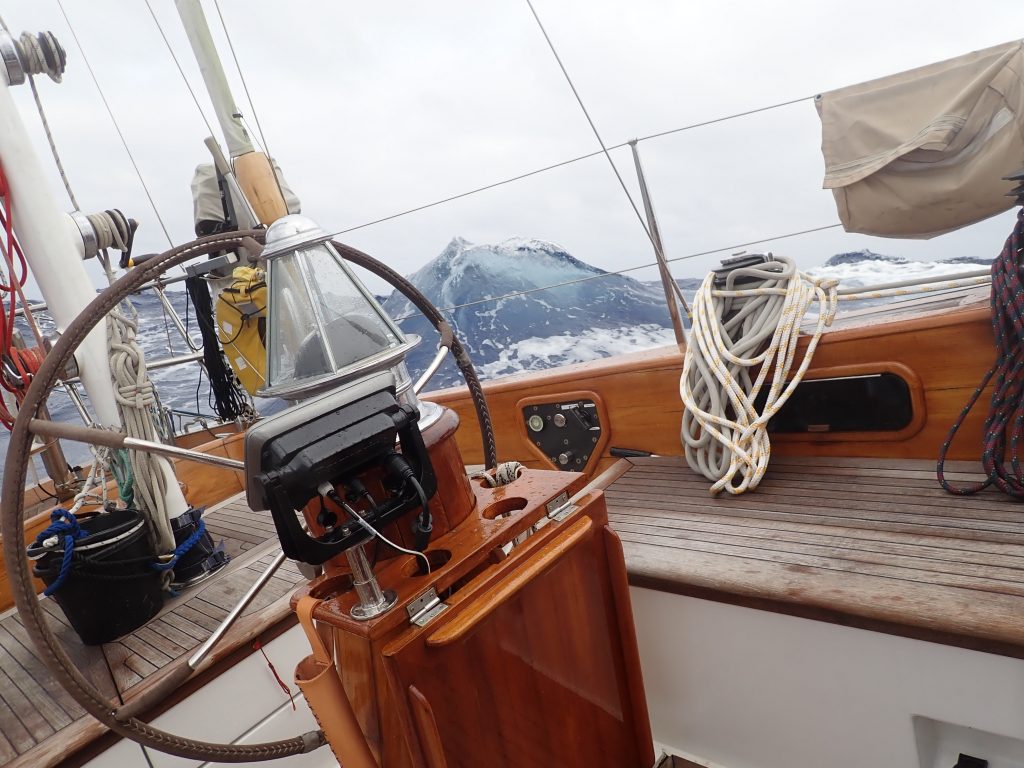
Now I know what sailing into winds force 6-7 in the Atlantic Ocean, gusting F8-9 with 3-4 metres of swell at short intervals looks and feels like. Once the sea had calmed down enough for me not to need both hands the whole time, I filmed it. It felt a LOT worse than it looked but any sailor will tell you that you need CGI special effects to really show what it feels like at sea in even slightly brisk winds. This felt like being in footage from The Perfect Storm, although in reality it didn’t look quite that bad.
Sailing like this might be a bit of a giggle, a thrill even, for a couple of hours. I can tell you from personal experience, this is not fun for hours and hours on end, not even on such a solid, amazing old classic Swan as Cesarina. Anyone who tells you otherwise is a garden pond sailor, a liar, or a sociopath, or perhaps all three.
We took turns to stay on deck in the wind and the wild spray. It got to the point where I was sure I could actually have fallen asleep standing up and I really had to concentrate hard to stay awake while Dietmar was getting some much-needed shut-eye. When I finally came off watch, I knew it was going to be hard to get some proper sleep so I carefully assembled a kind of soft cocoon in the saloon, between the table and the seating, using the seat cushions and the lee cloths which we usually never use. We were beating into the wind but the waves were on the beam, so we were rolling from left to right constantly; yawing 30 degrees to each side, easily rolling 60 degrees at a time on occasion. I took off my saltiest layers, clambered in and sort of slept, interrupted by technicolour anxiety dreams – exhausted but wired with adrenaline and anxiety and with my body moving all the time with the boat. Each time I woke, I felt like I’d been asleep for only five minutes. It was grim.
Below and above deck, the boat was OK even if the captain and crew were struggling. I was so happy that everything was stowed properly. The only minor problem was a locking catch on a drawer under the bed that failed and so every so often it would slide open with an almighty bang, hitting the end of its runners before running back in again. To begin with, we weren’t sure what the dreadful noise was, but were relieved to find it was just Dietmar’s underwear making the racket. I created a Heath Robinson solution to the problem, jamming a combination of knickers and a couple of facemasks into the gap and then ramming the drawer closed. No clean underwear for either of us for a couple of days, but we would have struggled to get them off or on again anyway without falling over, so this was pretty irrelevant. The fix held until we could mend it properly.
When it got dark, Dietmar refused to let me keep my watch and insisted that I stay below. This has only happened once before and that time was hideous too, but this time I didn’t argue or insist on coming up. Instead, I stayed below, tense with worry, dozing involuntarily at the chart table or checking the plotter. Every half hour or so I would peek through the hatch doors and ask if he was ok or needed anything. Often I would painstakingly and carefully make coffee or bring chocolate or fruit or energy bars, or anything I could find that required minimum preparation, and pass it up into the very wet cockpit. Dietmar was amazing that night, somehow managing to stay awake and keep us safe.
About eighteen hours into this ordeal, at about 5am, dog-tired and while it was still pitch dark, we suddenly heard a series of unholy bangs, audible above the roaring wind and thrumming of the waves past the hull. The noise was coming from somewhere near the mast. Dietmar opened the hatch door and said to me that he had to go on to the foredeck because the spinnaker boom had unhooked itself and was swinging around wildly like a 12 foot long baseball bat in the gale. He clipped on and went forward into the spray, on a bucking foredeck. Suddenly wide awake, I raced to get back into my oilies and lifejacket and went up on deck to sit at the wheel, clipped on, watching the waves trying to wash my husband off the deck. There are certain experiences in this life that I have no desire to repeat – needless to say, this was one of them.
Eventually, the sun rose and showed her face. Eventually, the wind calmed a little. Dietmar, like a bedraggled wild animal, crept below for some much-needed sleep. I took the watch and came on deck, bleary-eyed and numb. It was- finally – genuinely exhilarating sailing on a sapphire sea in sparkling sunshine, text-book beautiful. Physically and mentally exhausted, it was hard for either of us to find the appetite for it after the past 24 hours.
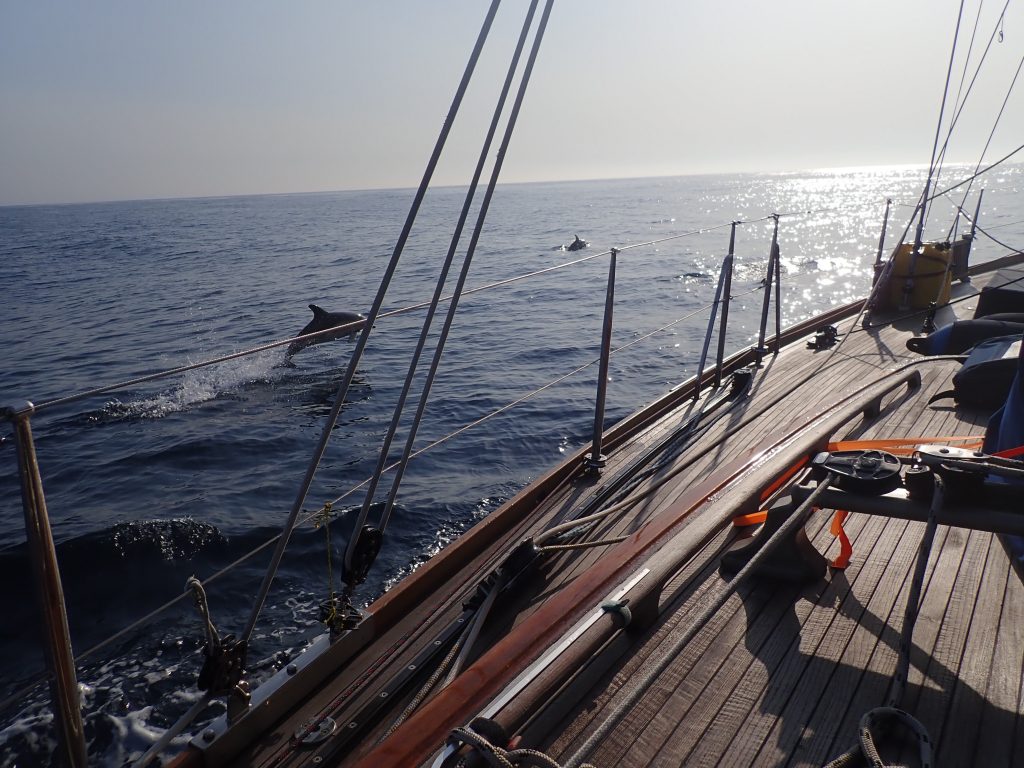
We set our course for Porto, salty as hell. I have no idea any more how long it took us – another day or so – but nothing of note happened in the meantime, apart from a beautiful dolphin escort for about half an hour, like chicken soup for the soul. Eventually, Porto showed itself like a sliver on the horizon and we were so glad to see it. Surrounded by cobalt blue and under a blazing sun, we both stripped and showered in the cockpit with a bucket of warm water, rinsing the storm away before we arrived.
Sailing into Porto is quite exciting. The Douro River runs powerfully out, punching its way through verdant countryside and then the city of Porto, through a steep sided and massive river valley before wrestling with the incoming tide every six hours or so around a manmade chicane of breakwaters at its mouth. The land, its steep sides clung with houses further inland, slides elegantly into the ocean, with a palm tree shady boulevard connecting the city with the harbour and the white sand beach. Vintage trams clink and click up and down along it, passing joggers and people pushing prams. The grey-green water bristles with small fishing boats (this seems to be a recurring theme at harbour entrances here in Portugal) where the river meets the Atlantic – we threaded a path between them all and were pushed in on a rising tide, past a small bay with a beach and then towards the marina which appeared quite soon on our right. Behind the many masts and modern buildings of the marina, a traditional, small fishing village – Afurada – remains. It has now been swallowed up as a suburb of Porto but maintains its old-fashioned ways. The smell of frying sardines wafted across to us from a terracotta waterfront bar as we rounded the buoy at the entrance. We saw the kids, gleeful and shrieking, jumping off the harbour wall into the water. It was hot. We were safe.
Once we’d tied up, wriggled gratefully out of our very salty lifejackets, turned the engine and all the instruments off, completed the log book for that trip and calculated how much diesel we had used, washed all the salt off the boat and out of the winches and lines and off the cockpit cushions, put the sails away properly, turned the tracking devices off, checked in at the marina office, done the accumulated washing up in the sink, rung my mother, filled the water tanks, bagged up the clothes for washing and done the thousand other little jobs that come with making landfall on Cesarina (and every other sailing boat, probably), we set about exploring our surroundings.
The marina is busy with party boats and day trippers and a hundred 10 foot long plastic fishing vessels that weave in and out of the marina. People learn how to sail, how to kayak and apparently how to get drunk on a boat here all day long. If you’re looking for peace and quiet, this isn’t the place (although the sunsets from here are breathtaking). We called an Uber.
The city of Porto itself, though, is fabulous. It’s extraordinarily beautiful, shabby, elegant, steeped in history, its hillside packed with townhouses of every pastel shade, some tiled in intricate patterns. There were a LOT of tourists – which came as a surprise – and plenty of things to buy or experience or otherwise consume. We licked ice cream and wandered through the charismatic narrow streets by the waterfront, fascinated by the old port cargo ships (the ‘rabelos’) that used to transport port wine in barrels down the Douro River and found it easy to imagine how this area would once have bustled with sailors and traders and barrowmen and whores.


We took one of those open-top bus tours to see a little more of the city and went out to the beach at Matosinhos, an area that used to be a stalwart of the fish canning industry but which died and now is being reborn as a chic, gentrified beachy suburb of Lisbon away from the traffic and bustle of the city centre.
We were particularly taken by a statue of a group of figures on the beach there. Much bigger than life size, it is of a group of five women and children, full of anguish, remonstrating with the sea, waiting hopelessly for their menfolk to come home. It memorialises the night of December 2nd 1947, when an unexpected storm whipped up 10 metre waves off this coast and wrecked 4 fishing boats not far from shore. The water claimed the lives of 152 sailors, leaving 71 widows and more than 100 children fatherless. Only six sailors survived the shipwrecks. It was the largest maritime tragedy then or since off this coastline. It resonated pretty hard with us.
Back in the city, we walked back across the enormous Dom Luis I suspension bridge and were surprised to see a small group of pretty cool-looking teenage boys in trainers and swimming trunks climb like monkeys up onto the parapet of the bridge. We watched with curiosity and not a little unease as they paraded back and forth on this foot-wide riveted section of bridge, 2 metres above the traffic, high above the dark waters of the massive Douro river streaming past 15 metres or so below. Bellowing like Tarzan to get the attention of the crowd admiring the view across to the city, they appeared to have a mate there passing a hat around.

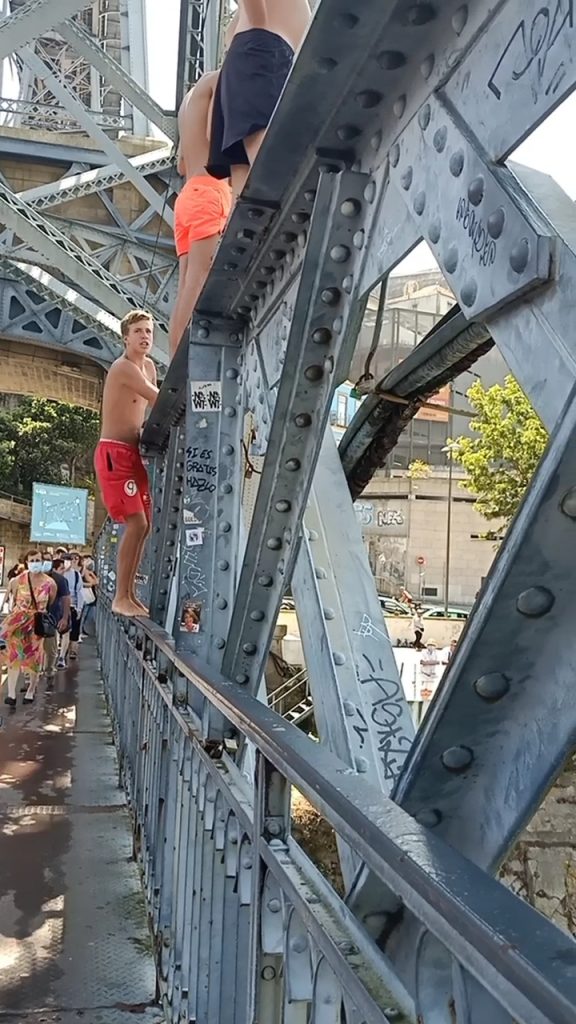
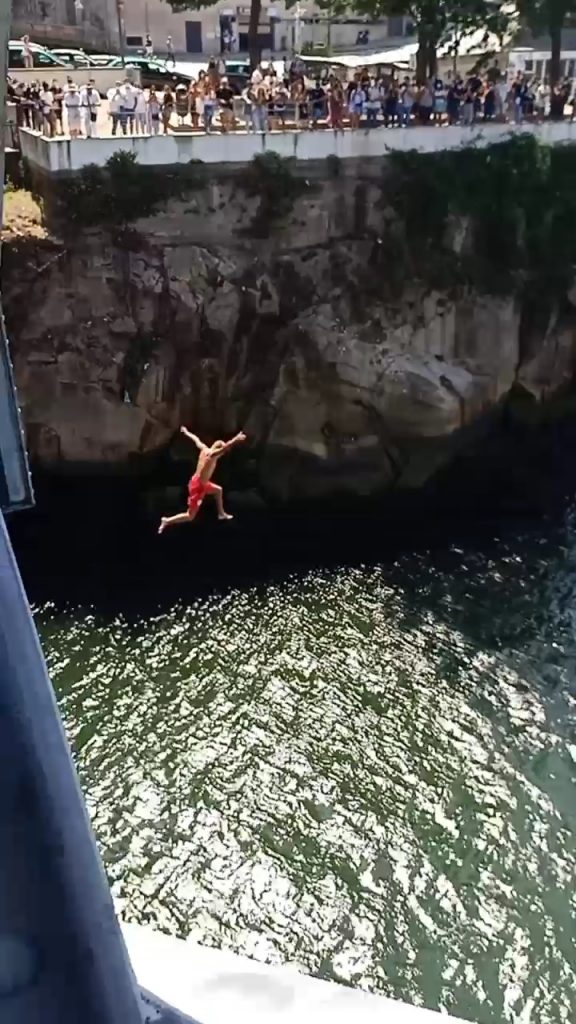

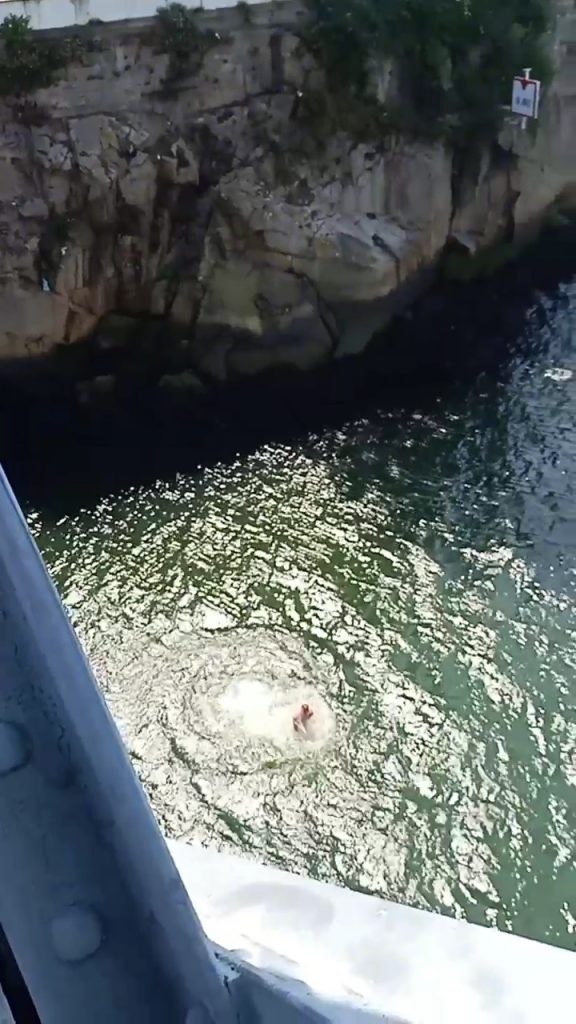
The three of them stood up there in the wind for a long time, goosebumps visible, occasionally holding on to a massive pillar and leaning out to look down, chatting slightly nervously amongst themselves. One of them eventually jumped. The crowd drew breath as he went under and cheered and clapped when he came up, laughing. After he had swum back to shore and the crowd waited expectantly, the other two hesitated, procrastinated, shifted from foot to foot. I honestly don’t blame them. It looked like a bloody long way down. Get it wrong and it would definitely hurt and possibly knock you unconscious, perhaps even kill you. The boys regained their bravado, bellowed and whistled some more, strutted up and down some more, looked down to check the distance some more, chatted to each other and laughed nervously some more – this went on for longer than Dietmar and I could be bothered to stand and watch. By the time we were the other side of the massive bridge, they were still standing and hollering. By the time we had eaten an ice cream, they were gone. No sirens, so we presume they lived to entertain and maybe jump another day.
We went into the city from the marina several times. Up the hill and away from the water, we swooned over the blue and white tiled train station entrance hall, the countless beautiful churches and the pastries. Dietmar sampled brioche croissants (he definitely prefers the original French-style) and bought a harmonica for the boat. We mooched through some shops and bought some little hand-stitched souvenirs for a small fortune. It was difficult to resist simply looking up the whole time – the buildings with their intricately tiled fronts or colourful paintwork and their beautiful wrought-iron balconies are mesmerising. 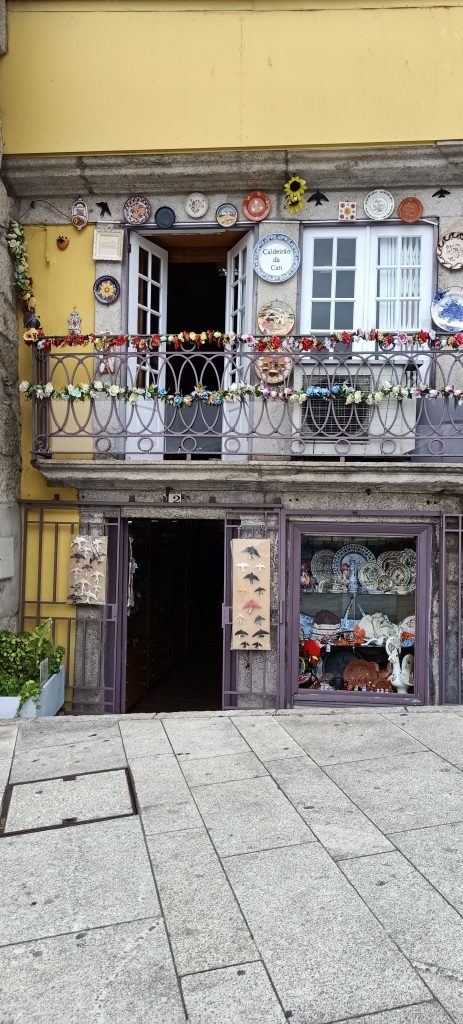
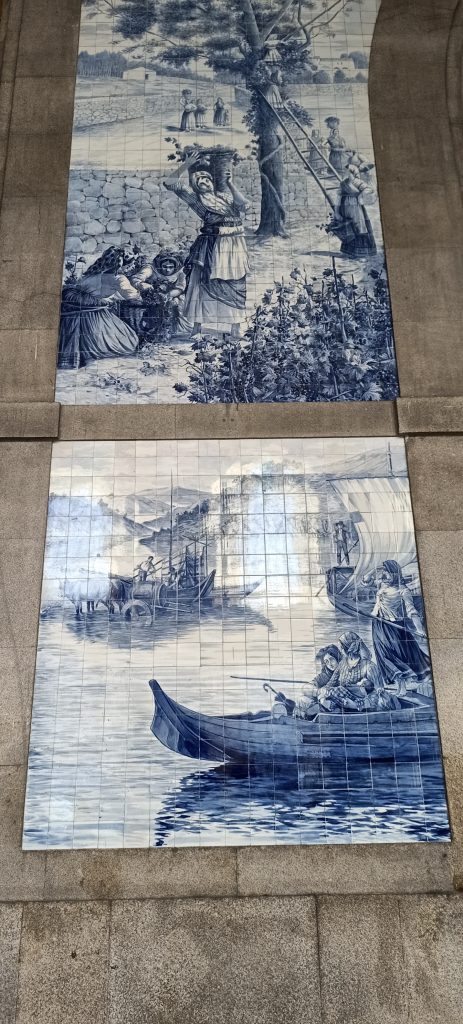

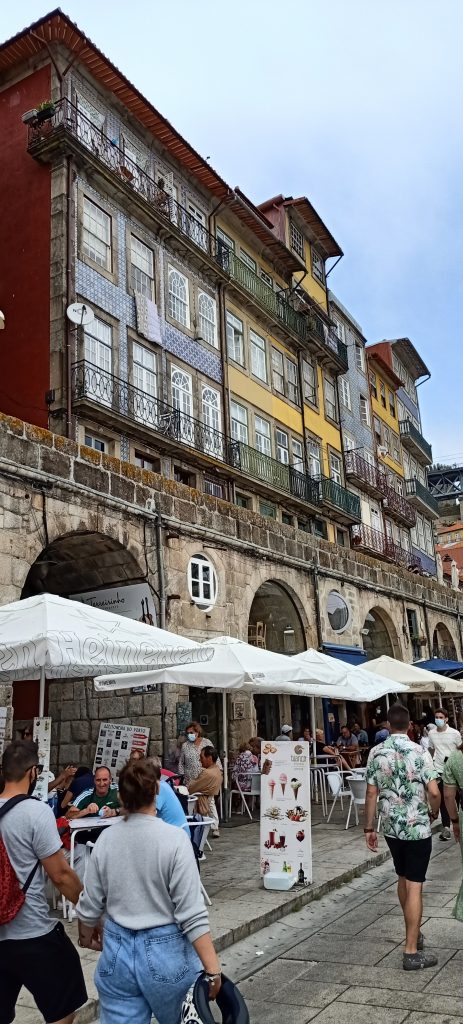
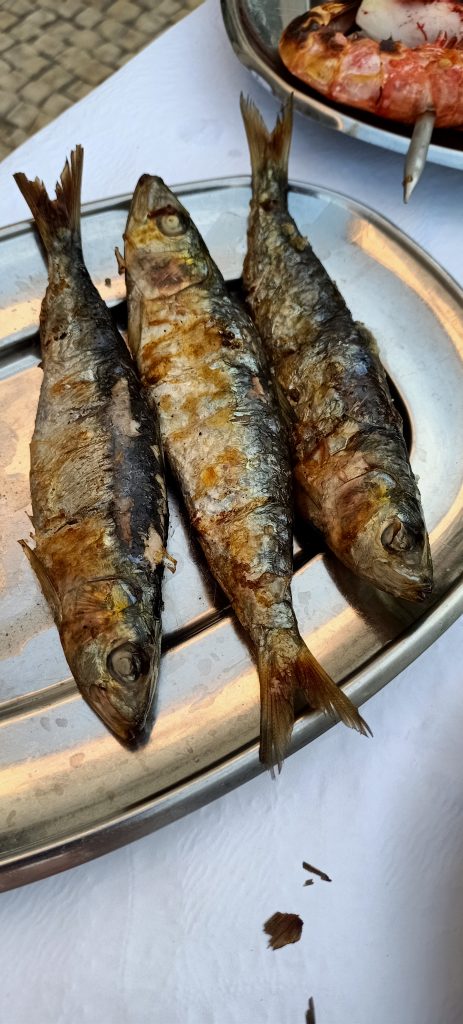
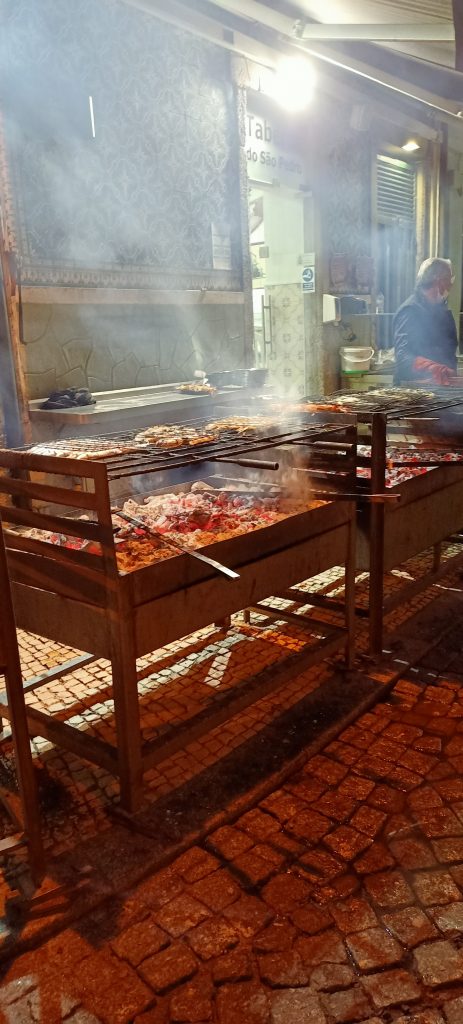


We hired a scooter (and gave it back after a day because the drivers in Porto are terrifying), ate some of the amazing fresh barbecued fish that we had smelled on our way in and did some washing (involving waiting a VERY long time for the one marina machine to become free. Did I already mention that I hate this part of the sailing life? 😉 ) We also went to a port tasting, got tipsy and bought everything they had in stock. OK, not quite, but Cesarina definitely sits a little lower in the water since the port wine was loaded onboard…
We also met up with an old friend of Dietmar’s while we were in Porto – Ricardo and Dietmar met when Dietmar was there for the first time, seven years ago, freshly free from his business and with his then new boat, ‘Summer.’ After some confusion (on his part) about whether or not he and I had met before (Ricardo thought I was Katja, which was very funny and not a little puzzling), we feasted and drank with his wife and son and beautiful (and very barky) dog until the wee small hours, working our way through a lot of seafood, several bottles of local wine and sampling their amazing collection of port, including one from 1880. I had a deserved headache the next morning, I can tell you!
We left Porto, eventually, after 6 nights in the marina with our livers just about intact and our reserves of courage and energy topped up. It was time to venture back out into the wild, free ocean for new adventures. We were ready.
Time to head south…


Terrific read! I could taste the salt spray ,feel the motion and the relief of making it back to calm waters. Best of luck going south.
Awwww, thanks Maik! and yes, please cross your fingers for us – sailing is also lovely when all goes to plan! 😉 Emma & Dietmar
What a wonderful after lunch read whilst sitting beneath my sunshade on a glorious sun drenched day in Kent. I felt every splash of sea water on my skin which leaves crusty salt layers when dry and relived the anguish of the next large thumping noise wondering whether the keel has broken away having hit a floating container just below the waves. You must colate and publish these wonderful bloggs. Thank you my handsome for spiriting my soul away to other parts. Lots of love to you both and may your waters be calm and your future be bright. Mr. G. Xx
Awwww, thank you so much for the lovely feedback! I hope the weather continues fine in sunny Kent – we will be back for a little while in a few weeks. Hope you’re keeping very well – and I’m delighted to be spiriting you away! There’s more on the way. And who knows, perhaps I’ll have enough written for it to merit being bound… one day! With love, Em xxxx
Brilliant Emma, I was with you every wave on the way. Looking forward to you next adventure. Fair winds and Safe passage. Xxxx
Thanks Sue! There’s more coming, I’m sure! We’re currently holed up in Sines, with orcas stalking the coastline and biting people’s rudders off! It’s a bit of a nightmare… we are hoping to slip past tomorrow but you can be sure I will write about whatever happens! It’s a bit nerve-wracking, I can tell you! Love to you and Tristan xx
Read the story with great interest, recognizable but not with pleasure. May hope that this gained experience does not have to be used again. Good luck going south, Jan “Queen of Hearts”
Thank you Jan – so do we!
Thank you for reading and taking the time to comment. Will we bump into you somewhere on our way south this year?
best wishes,
Emma